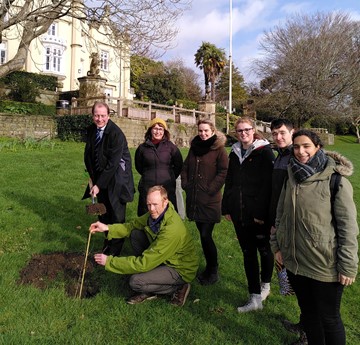Ben Sampson is a member of the University’s sustainability team, specifically looking after campus biodiversity & Crymlyn Burrows’ site of special scientific interest at the Bay Campus.
How did you start your career in conservation?
I originally studied marine biology, then took up a full-time volunteering role at Newborough Warren National Nature Reserve on Anglesey. This led to volunteering across Britain and Ireland for the RSPB, the British Trust for Conservation Volunteers and others, living in amazing places, working with amazing people and developing the skills and experience needed. A Masters in Coastal and Estuarine Science and Management then accelerated my career.
Has conservation taken you to any interesting places?
I’ve been really lucky to have lived and worked in some stunning locations – island conservation is very close to my heart and I have lived on several small islands over the years, with a four year stretch on Lundy in the Bristol Channel being a particular highlight (and not just because I met my wife there!) but my favourite has to have been my two years on Aride Island in Seychelles. This tiny tropical island is home to over a million seabirds, several endemic plants and animals and the highest density of lizards on earth.
What is the biggest challenge for biodiversity right now?
Climate change alone has the capability of causing mass extinctions, but when so much of the planet has been modified by humans, the natural world is far less resilient to change than it would otherwise be.
This impacts on a local and global level, with locally important wildlife hotspots under pressure from development, habitat fragmentation, the spread of invasive species and extreme weather. Addressing these challenges means working to protect important sites and ensuring they are well-managed, for example, improving connectivity to enable animals and plants to move through the landscape, while controlling the spread of invasive species. We need to increase the resilience of the natural environment so that it is in the best possible condition to withstand inevitable change.
How does biodiversity vary between Swansea University campuses?
Singleton Park campus is a wonderful mosaic of habitats, from open grassland with mature trees, scrub, woodland, ponds, formal flowerbeds and buildings of a range of ages that leads to a high biodiversity, providing food and shelter for a wide range of species. The very old oak trees in particular harbour a huge range of other plants, animals and fungi.
The Bay Campus, being newly built has a much lower biodiversity, though planting of trees and wildflowers are already bringing some rare wildlife onto campus. The dunes and saltmarsh of Crymlyn Burrows, managed as a nature reserve by the University, are of national importance for their biodiversity and are designated as a site of special scientific interest. The whole area is open to visitors and well worth a lunchtime stroll for a bit of ecotherapy.

